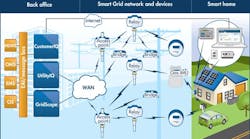Load leveling, the implementation of a closed feedback loop that modulates minute-by-minute demand for electricity across the continent, is one of the long-term goals of the Smart Grid. The idea is that we have, on average, sufficient energy generation and transmission capacity to meet demand. The catch lies in those two words: “on average.” When the weather in some places gets really hot or really cold, when it’s time to cook supper, or when the Super Bowl is on, demand can peak at a level above or perilously close to what the grid can deliver.
The obvious solution would be to build more capacity. But between environmental regulations and “not-in-my-backyard” neighbors in places where it might make sense to site a plant or run a transmission line, it’s all but impossible to obtain the necessary permits. In a totalitarian state or a banana republic, the government could arbitrarily cut off some customers when demand got high enough to put the whole system at risk.
Related Articles
In most places, though, that’s out of the question. So the power industry, in the form of the industry-funded Electric Power Research Institute (EPRI) and the federal National Institute for Science and Technology (NIST), developed the Smart Grid. NIST’s role in particular is to create the standards that will describe how the Smart Grid works.1
The plan they came up with, which is still a work in progress, is a feedback loop in which the real-time price to the electricity consumer goes up when demand rises and goes down when it diminishes. Part of the process involves informing electricity customers of the impending change in rates via the one thing that all electricity users have in common: the metering device at the service-drop to the building.
It would be absurd to imagine most electricity users keeping a constant eye on constantly changing rates of pennies per kilowatt hour. So, each electric meter would communicate with the household’s or business’ major power-sucking appliances, which would compare near-future rates with consumer-set trigger points and defer certain operations whenever the rates exceeded some trigger point, resuming when the rate had dropped sufficiently or the user overrode the preset.
In other words, it would be a classic closed-loop control system2. The obvious questions, then, would be how the feedback signal will be generated and what kind of time constant the system would require.
Leaving the price setting up to the generators and transmitters of electrical energy would not do. That would not be a free-market environment. Have the government set the pricing? That already happens in a way, when regulators cap prices and refuse to allow electricity retailers to shut down seniors who are late paying their bills—not to mention that the time-constant for any kind of regulatory action is too long to even contemplate.
Instead, the Smart Grid is supposed to be a reasonable approximation of a free-market experience. The actual parameters are far from being set, but it is expected that the real-time buying and selling of electricity on the New York and Chicago Stock Exchange will be used in an algorithm (also as yet undefined) that will control the changes in pennies per kilowatt hour sent to everybody’s electric meter.
This is far from a pipe dream. Studies with actual electric utilities and their real customers have been (and are still being) conducted in which rates vary and appliances turn on or wait for a better offer.
Demand Response Today
To get a quick look at the state of the art in demand balancing, consider Silver Spring Networks’ Smart Energy Platform, which comprises back-office software, the Silver Spring Smart Grid network, and turnkey services that enable utilities to deploy broad-scale load control and pricing-based demand response programs. Thanks to NIST and industry standards, that all works with third-party in-home devices.
The first elements in Silver Springs’ Demand Response software platform are its UtilityIQ HCM communications manager and Demand Optimizer software products. UtilityIQ HCM provides the ability to define and manage Demand Response programs, manage customer devices, manage the network linking to customers’ homes, define devices, and send Demand Response events and messages. The Demand Optimizer provides advanced analytics and real-time feedback utilities that can be used to forecast and measure load-shed and validate the results of their Demand Response programs.
All of the GE and Landis+Gyr (now Toshiba) meters I have seen in California have been tagged to indicate that they include Silver Spring Networks communication modules that can provide connectivity into the home. Silver Spring Networks supports the ZigBee Smart Energy Profile specification for home area network (HAN) devices. The company also supports a HAN device qualification program to ensure end-to-end interoperability with in-home devices and the utilities’ Demand Response programs.
Furthermore, Silver Spring Networks’ “Direct-to-Grid” communications solutions support IPv6 communications modules that can be integrated into third-party devices such as load control switches and electric-vehicle charging stations. On the consumer side, the company’s CustomerIQcustomer engagement platform offers Demand Response participants advance notice of upcoming Demand Response events and an immediate view into their usage patterns.
References:
